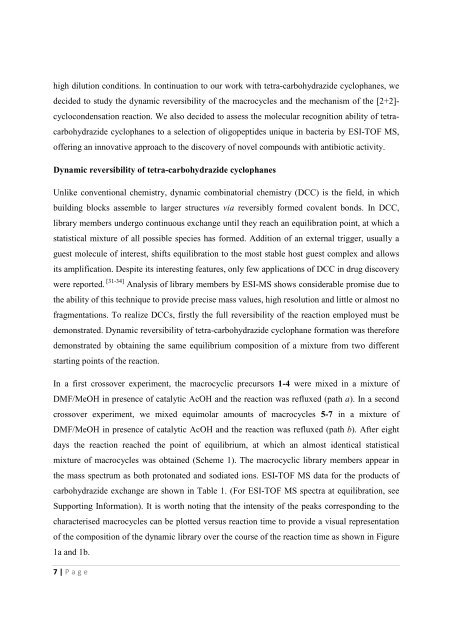The Development of Novel Antibiotics Using ... - Jacobs University
The Development of Novel Antibiotics Using ... - Jacobs University
The Development of Novel Antibiotics Using ... - Jacobs University
You also want an ePaper? Increase the reach of your titles
YUMPU automatically turns print PDFs into web optimized ePapers that Google loves.
high dilution conditions. In continuation to our work with tetra-carbohydrazide cyclophanes, we<br />
decided to study the dynamic reversibility <strong>of</strong> the macrocycles and the mechanism <strong>of</strong> the [2+2]-<br />
cyclocondensation reaction. We also decided to assess the molecular recognition ability <strong>of</strong> tetracarbohydrazide<br />
cyclophanes to a selection <strong>of</strong> oligopeptides unique in bacteria by ESI-TOF MS,<br />
<strong>of</strong>fering an innovative approach to the discovery <strong>of</strong> novel compounds with antibiotic activity.<br />
Dynamic reversibility <strong>of</strong> tetra-carbohydrazide cyclophanes<br />
Unlike conventional chemistry, dynamic combinatorial chemistry (DCC) is the field, in which<br />
building blocks assemble to larger structures via reversibly formed covalent bonds. In DCC,<br />
library members undergo continuous exchange until they reach an equilibration point, at which a<br />
statistical mixture <strong>of</strong> all possible species has formed. Addition <strong>of</strong> an external trigger, usually a<br />
guest molecule <strong>of</strong> interest, shifts equilibration to the most stable host guest complex and allows<br />
its amplification. Despite its interesting features, only few applications <strong>of</strong> DCC in drug discovery<br />
were reported. [31-34] Analysis <strong>of</strong> library members by ESI-MS shows considerable promise due to<br />
the ability <strong>of</strong> this technique to provide precise mass values, high resolution and little or almost no<br />
fragmentations. To realize DCCs, firstly the full reversibility <strong>of</strong> the reaction employed must be<br />
demonstrated. Dynamic reversibility <strong>of</strong> tetra-carbohydrazide cyclophane formation was therefore<br />
demonstrated by obtaining the same equilibrium composition <strong>of</strong> a mixture from two different<br />
starting points <strong>of</strong> the reaction.<br />
In a first crossover experiment, the macrocyclic precursors 1-4 were mixed in a mixture <strong>of</strong><br />
DMF/MeOH in presence <strong>of</strong> catalytic AcOH and the reaction was refluxed (path a). In a second<br />
crossover experiment, we mixed equimolar amounts <strong>of</strong> macrocycles 5-7 in a mixture <strong>of</strong><br />
DMF/MeOH in presence <strong>of</strong> catalytic AcOH and the reaction was refluxed (path b). After eight<br />
days the reaction reached the point <strong>of</strong> equilibrium, at which an almost identical statistical<br />
mixture <strong>of</strong> macrocycles was obtained (Scheme 1). <strong>The</strong> macrocyclic library members appear in<br />
the mass spectrum as both protonated and sodiated ions. ESI-TOF MS data for the products <strong>of</strong><br />
carbohydrazide exchange are shown in Table 1. (For ESI-TOF MS spectra at equilibration, see<br />
Supporting Information). It is worth noting that the intensity <strong>of</strong> the peaks corresponding to the<br />
characterised macrocycles can be plotted versus reaction time to provide a visual representation<br />
<strong>of</strong> the composition <strong>of</strong> the dynamic library over the course <strong>of</strong> the reaction time as shown in Figure<br />
1a and 1b.<br />
7 | P a g e

















